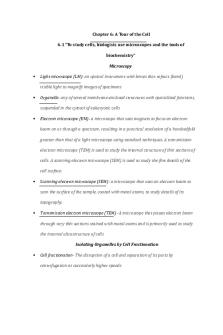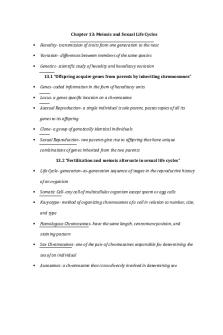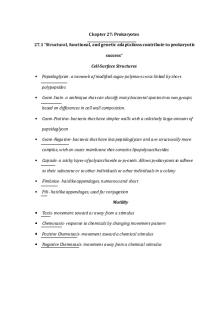Chapter 6 Vocab - Summary Campbell Biology PDF

| Title | Chapter 6 Vocab - Summary Campbell Biology |
|---|---|
| Course | Introduction to Biology A |
| Institution | University of Pennsylvania |
| Pages | 11 |
| File Size | 182.8 KB |
| File Type | |
| Total Downloads | 32 |
| Total Views | 138 |
Summary
Vocab definitions...
Description
Chapter 6: A Tour of the Cell 6.1 “To study cells, biologists use microscopes and the tools of biochemistry” Microscopy
Light microscope (LM)- an optical instrument with lenses that refract (bend) visible light to magnify images of specimens
Organelle- any of several membrane-enclosed structures with specialized functions, suspended in the cytosol of eukaryotic cells
Electron microscope (EM)- a microscope that uses magnets to focus an electron beam on or through a spectrum, resulting in a practical resolution of a hundredfold greater than that of a light microscope using standard techniques. A transmission electron microscope (TEM) is used to study the internal structure of thin sections of cells. A scanning electron microscope (SEM) is used to study the fine details of the cell surface.
Scanning electron microscope (SEM) - a microscope that uses an electron beam to scan the surface of the sample, coated with metal atoms, to study details of its topography.
Transmission electron microscope (TEM) - A microscope that passes electron beam through very thin sections stained with metal atoms and is primarily used to study the internal ultrastructure of cells Isolating Organelles by Cell Fractionation
Cell fractionation- The disruption of a cell and separation of its parts by centrifugation at successively higher speeds
Ultracentriguges- the most powerful machines? 6.2 “Eukaryotic cells have internal membranes that compartmentalize their functions” Comparing Prokaryotic and Eukaryotic Cells
Cytosol- semifluid in the plasma membrane where organelles are found
Prokaryotic cell- No nucleus, DNA is in an unbound region called the nucleoid, no membrane-bound organelles, cytoplasm bound by the plasma membrane Pr
Nucleoid- A non-membrane-bounded region in a prokaryotic cell where the DNA is concentrated
Eukaryotic cell- a type of cell with membrane-enclosed nucleus and membraneenclosed organelles. Organisms with eukaryotic cells (protists, fungi, and animals) are called eukaryotes
Cytoplasm- The contents of the cell bounded by the plasma membrane; in eukaryotes, the portion exclusive of the nucleus
Plasma membrane- The membrane at the boundary of every cell that acts as a selective barrier, regulating the cell's chemical composition 6.3 “The eukaryotic cell’s genetic instructions are houses in the nucleus and carried out by the ribosomes” The Nucleus: Genetic Library of the Cell
Nucleus- An atom's central core, containing protons and neutrons; the organelle of a eukaryotic cell that contains the genetic material in the form of chromosomes, made up of chromatin; a cluster of neutrons
Nuclear envelope- in a eukaryotic cell, the double membrane that surrounds the nucleus, perforated with pores that regulate traffic with the cytoplasm. The outer membrane is continuous with the endoplasmic reticulum
Nuclear lamina- A netlike array of protein filaments that lines the inner surface of the nuclear envelope and helps maintain the shape of the nucleus
Chromosome- A cellular structure carrying genetic material, found in the nucleus of eukaryotic cells. Each chromosome consists of one very long DNA molecule and associated proteins (a bacterial chromosome usually consists of a single circular DNA molecule and associated proteins. It is found in the nucleoid region, which is not membrane bounded.
Chromatin- The complex of DNA and proteins that makes up eukaryotic chromosomes. When the cell is not dividing, chromatin exists in its dispersed form, as a mass of very long, thin fibers that are not visible with a light microscope
Nucleolus- A specialized structure in the nucleus, consisting of chromosomal regions containing ribosomal RNA (rRNA) genes along with ribosomal proteins imported from the cytoplasm; site of rRNA synthesis and ribosomal subunit assembly Ribosomes: Protein Factories in the Cell
Ribosome- A complex of rRNA and protein molecules that function as a site of protein synthesis in the cytoplasm; consists of a large and small subunit. In eukaryotic cells, each subunit is assembled in the nucleolus 6.4 “The endomembrane system regulates protein traffic and performs metabolic functions in the cell”
Endomembrane system- The collection of membranes inside and surrounding a eukaryotic cell, related either through direct physical contact or by the transfer of membranous vesicles; includes the plasma membrane, the nuclear envelope, the smooth and rough endoplasmic reticulum, the Golgi apparatus, lysosomes, vesicles, and vacuoles
Vesicle- A membranous sac in the cytoplasm of a eukaryotic cell The Endoplasmic Reticulum: Biosynthetic Factory
Endoplasmic reticulum (ER) - An extensive membranous network in eukaryotic cells, continuous with the outer nuclear membrane and composed of ribosomestudded (rough) and ribosome-free (smooth) regions
Smooth endoplasmic reticulum- The portion of the ER that is free of ribosomes; the portion of the endomembrane system important in lipid synthesis, detoxification, and calcium storage
Rough endoplasmic reticulum- The portion of the ER with ribosomes attached Functions of Rough ER
Glycoprotein- A protein with one or more covalently attached carbohydrates
Transport vesicle- A small membranous sac in a eukaryotic cell's cytoplasm carrying molecules produced by the cell The Golgi Apparatus: Shipping and Receiving Center
Golgi apparatus- An organelle in eukaryotic cells consisting of stacks of flat membranous sacs that modify, store, and route products of the ER and synthesize some products, notably noncellular carbohydrates Lysosomes: Digestive Compartments
Lysosome - a membrane-enclosed sac of hydrolytic enzymes found in the cytoplasm of animal cells and some protists. Contains a stockpile of digestive enzymes, important in breaking down nutrients, destroying bacteria, recycling, and development
Phagocytosis- a type of endocytosis in which large particulate substances or small organisms are taken up by a cell. It's carried out by some protists and by certain immune cells of animals (in mammals, mainly macrophages, neutrophilis, and dendritic cells). Vacuoles: Diverse Maintenance Compartments
Food vacuole- A membranous sac formed by phagocytosis of microorganisms or particles to be used as food by the cell
Contractile vacuole- A membranous sac formed that helps moves excess water out of certain freshwater protists
Central vacuole- In a mature plant cell, a large membranous sac with diverse roles in growth, storage, and sequestration of toxic substances
Tonoplast - membrane that enclose the central vacuole 6.5 “Mitochondria and chloroplasts change energy from one form to another”
Mitochondria- The organelle in eukaryotic cells that carries out cellular respiration, the process of converting the chemical energy of sugars and other molecules to chemical energy in the form of ATP.
Chloroplast- An organelle found in plants and photosynthetic protists that absorbs sunlight and uses it to drive the synthesis of organic compounds from carbon dioxide
Peroxisome- an oxidative organelle that is not part of the endomembrane system Mitochondria: Chemical Energy Conversion
Cristae- an infolding of the inner membrane of a mitochondrion. The inner membrane houses electron transport chains and molecules of the enzyme catalyzing the synthesis of ATP (ATP synthase)
Mitochondrial matrix - The compartment of the mitochondrion enclosed by the inner membrane and containing enzymes and substrates for the citric acid cycle, as well as ribosomes and DNA Chloroplasts: Capture of Light Energy
Plastids- One of a family of closely related organelles that includes chloroplasts, chromoplasts, and amlyoplasts. Found in cells of photosynthetic eukaryotes
Thylakoid- A flattened, membranous sac inside a chloroplast. Often exist in stacks called grana that are interconnected; their membranes contain molecular "machinery" used to convert light energy to chemical energy
Granum- a stack of membrane-bounded thylakoids in the chloroplast. Grana function in the light reactions of photosynthesis
Stroma- The dense fluid within the chloroplast surrounding the thylakoid membrane and containing ribosomes and DNA; involved in the synthesis of organic molecules from carbon dioxide and water
6.6 “The cytoskeleton is a network of fibers that organizes structures and activities in the cell”
Cytoskeleton- A network of microtubules, microfilaments, and intermediate filaments that extend throughout the cytoplasm and serve a variety of mechanical, transport, and signaling function. Roles of the Cytoskeleton: Support, Motility, and Regulation
Motor protein- A protein that interacts with microtubules, producing movement of organelles and/or vesicles Components of the Cytoskeleton
Microtubules- A hollow rod composed of tubulin proteins that makes up part of the cytoskeleton in all eukaryotic cells and is found in cilia and flagella
Microfilament- A cable composed of actin proteins in the cytoplasm of almost every eukaryotic cell, making up part of the cytoskeleton and acting alone or with myosin to cause cell contraction; aka actin filament
Intermediate filament - A component of the cytoskeleton that includes filaments intermediate in size between microtubules and microfilaments Microtubules
Centrosome- A structure present in the cytoplasm of animal and plant cells that functions as a microtubule-organizing center and is important during cell division
Centrioles- The centrosome and microtubule organizing center of animal cells; barrel shaped structures arranged at 90 degree angles to each other; produces the cytoskeleton; always located in close proximity to the nucleus
Flagella- A long cellular appendage specialized for locomotion. Like motile cilia, eukaryotic flagella have a core with 9 outer doublet microtubules and 2 inner single microtubules (the "9+2" arrangement) ensheathed in an extension of the plasma membrane.
Cilia- A short appendage containing microtubules in eukaryotic cells. A motile cillium is specialized for locomotion or moving fluid past the cell; formed from a core of 9 outer doublet microtubules and 2 inner single microtubules (the "9+2" arrangement) ensheathed in an extension of the plasma membrane. Primary cillium usually nonmotile and plays sensory and signaling role; lack 2 inner microtubules (the "9+0" structure)
Basal body- a eukaryotic cell structure consisting of a "9+0" arrangement of microtubule triplets. The basal body may organize the microtubule assembly of a cilium or flagellum and is structurally very similar to a centriole
Dynein - In cilia and flagella, a large motor protein extending from 1 microtubule doublet to the adjacent doublet. ATP hydrolysis drives changes in its shape that lead to bending of cilia and flagella Microfilaments (Actin Filaments)
Actin- A globular protein that links into chains, 2 of which twist helically about each other, forming microfilaments (actin filaments) in muscle and other kinds of cells
Cortex- Outer region of cytoplasm in a eukaryotic cell, lying just under the plasma membrane, that has a more gel-like consistency that the inner regions due to the
presence of multiple microfilaments; in plants, ground tissue that is between the vascular tissue and the dermal tissue in a root or eudicot stem
Myosin- A type of motor protein that associates into filaments that interact with actin filaments to cause cell contraction
Pseudopodia- A cellular extension of amoeboid cells used in moving and feeding
Cytoplasmic streaming - A circular flow of cytoplasm, involving interactions of myosin and actin filaments, that speeds the distribution of materials within cells 6.7 “Extracellular components and connections between cells help coordinate cellular activities” Cell Walls of Plants
Cell wall- a protective layer external to the plasma membrane in the cells of plants, prokaryotes, fungi and some protists. Polysaccharides such as cellulose (in plants and some protists), chitin (in fungi), and peptidoglycan (in bacteria) are important structural components of them
Primary cell wall- The level of protein structure referring to the specific linear sequence of amino acids
Middle lamella- In plants, a thin layer of adhesive extracellular material, primarily pectins, found between the primary walls of adjacent young cells
Secondary cell wall - Regions of repetitive coiling of folding of the polypeptide backbone of a protein due to hydrogen bonding between constituents of the backbone (not the side chains) The Extracellular Matrix (ECM) of Animal Cells
Extracellular matrix (ECM) - The meshwork surrounding animal cells, consisting of glycoproteins, polysaccharides and proteoglycans synthesized and secreted by the cells
Collagen - A glycoprotein in the extracellular matrix of animal cells that forms strong fibers, found extensively in connective tissue and bone; the most abundant protein in the animal kingdom
Integrin- In animal cells, a transmembrane receptor protein with 2 subunits that interconnects the extracellular matrix and the cytoskelteton Intracellular Junctions Plants: Plasmodesmata
Plasmodesmata- An open channel through the cell wall that connects the cytoplasm of adjacent plant cells, allowing water, small solutes, and some larger molecules to pass between the cells; similar in function to gap junctions of animal cells
Tight junction- A type of intercellular junction between animal cells that prevents the leakage of material through the space between cells
Desmosomes- A type of intercellular junction in animal cells that functions as a rivet, fastening cells together
Gap junction- A type of intercellular connection in animal cells, consisting of proteins surrounding a pore that allows the passage of materials between cells
Fimbriae- As it pertains to Prokaryotic Cells, which structures, are surface appendages that allow a bacterium to stick to a surface
Nucleic acid- A polymer (polynucleotide) consisting of many nucleotide monomers; serves as a blueprint for proteins and, through the actions of proteins, for all cellular activities. The two types are DNA and RNA.
Deoxyribonucleic acid (DNA)- A double-stranded, helical nucleic acid molecule capable of replicating and determining the inherited structure of a cell’s proteins....
Similar Free PDFs

Ch26 - Summary Campbell Biology
- 6 Pages
Popular Institutions
- Tinajero National High School - Annex
- Politeknik Caltex Riau
- Yokohama City University
- SGT University
- University of Al-Qadisiyah
- Divine Word College of Vigan
- Techniek College Rotterdam
- Universidade de Santiago
- Universiti Teknologi MARA Cawangan Johor Kampus Pasir Gudang
- Poltekkes Kemenkes Yogyakarta
- Baguio City National High School
- Colegio san marcos
- preparatoria uno
- Centro de Bachillerato Tecnológico Industrial y de Servicios No. 107
- Dalian Maritime University
- Quang Trung Secondary School
- Colegio Tecnológico en Informática
- Corporación Regional de Educación Superior
- Grupo CEDVA
- Dar Al Uloom University
- Centro de Estudios Preuniversitarios de la Universidad Nacional de Ingeniería
- 上智大学
- Aakash International School, Nuna Majara
- San Felipe Neri Catholic School
- Kang Chiao International School - New Taipei City
- Misamis Occidental National High School
- Institución Educativa Escuela Normal Juan Ladrilleros
- Kolehiyo ng Pantukan
- Batanes State College
- Instituto Continental
- Sekolah Menengah Kejuruan Kesehatan Kaltara (Tarakan)
- Colegio de La Inmaculada Concepcion - Cebu














